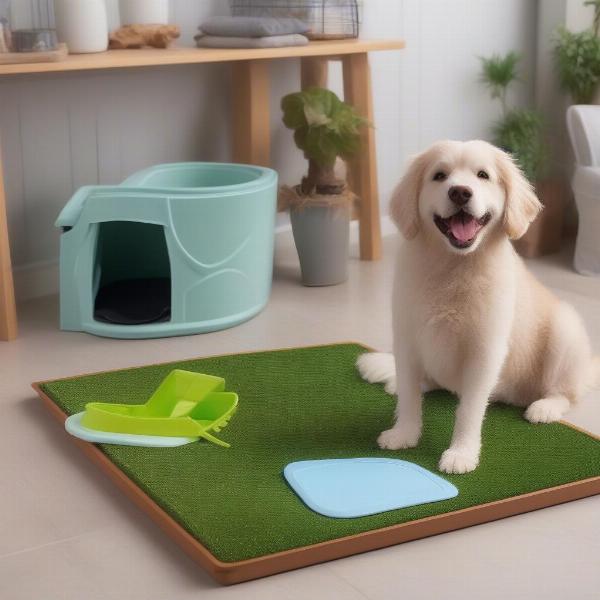Creating an indoor bathroom for your dog can be a game-changer, offering convenience and a reliable solution for potty breaks, especially in apartments, during bad weather, or for dogs with mobility issues. This guide explores everything you need to know about setting up and maintaining an effective indoor bathroom for your canine companion.
Choosing the Right Indoor Potty System
 Indoor Dog Potty Options
Indoor Dog Potty Options
Several options are available, each catering to different needs and preferences. Pee pads are a popular choice due to their affordability and ease of use. Simply place the pad in a designated area and replace it regularly. Faux grass patches offer a more natural feel and can be easily cleaned. Litter box style systems utilize absorbent pellets or crystals, minimizing odor and mess. Consider your dog’s size, personality, and your own lifestyle when selecting the best system. A larger dog might require a larger area or a more robust system.
Training Your Dog to Use the Indoor Bathroom
Introducing your dog to their new indoor bathroom requires patience and positive reinforcement. Start by confining your dog to the area where the potty is located, particularly after meals, naps, and playtime. When your dog uses the potty correctly, reward them with praise, treats, or a favorite toy. Consistency is key. If your dog has an accident, clean the area thoroughly with an enzymatic cleaner to eliminate odors and discourage repeat offenses. Never punish your dog for accidents; this will only create anxiety and make training more difficult.
Maintaining a Hygienic Indoor Dog Bathroom
Regular cleaning is crucial to prevent odors and maintain a sanitary environment. For pee pads, dispose of soiled pads promptly. Faux grass patches should be rinsed and cleaned with a pet-safe disinfectant. Litter box systems require regular scooping and replacement of the absorbent material. A well-maintained indoor bathroom is essential for both your dog’s health and your own comfort.
Tips for Odor Control
- Use an enzymatic cleaner specifically designed for pet messes.
- Ensure adequate ventilation in the designated potty area.
- Consider adding baking soda to the bottom of litter box systems to absorb odors.
- Regularly clean and disinfect the entire potty area, not just the soiled portions.
Addressing Common Challenges
Some dogs may be resistant to using an indoor bathroom at first. If your dog continues to have accidents, reassess the location of the potty, the type of system you’re using, and your training methods. Consulting with a veterinarian or a certified dog trainer can be beneficial if you encounter persistent challenges. my dog won't go to the bathroom outside anymore provides additional insights on addressing changes in your dog’s potty habits.
Benefits of an Indoor Dog Bathroom
An indoor bathroom offers numerous advantages for both dogs and their owners. It provides a convenient solution for potty breaks, especially in inclement weather or for dogs with limited mobility. It can also be helpful for apartment dwellers or those with busy schedules. faux grass dog potty and dog spray to potty train offer more specific information on different potty training solutions.
Conclusion
Setting up an indoor bathroom for your dog requires careful consideration and planning. Choosing the right system, consistent training, and regular maintenance are key to success. An indoor bathroom can offer a convenient and hygienic solution for potty breaks, improving both your dog’s quality of life and your own. best flooring for dogs who pee offers helpful advice on choosing flooring that complements your indoor potty solution.
FAQ
- How often should I clean my dog’s indoor bathroom? Ideally, clean the potty area after each use for pee pads. For other systems, daily cleaning is recommended.
- What if my dog refuses to use the indoor bathroom? Reassess the location, the type of system, and your training methods. Consult a veterinarian or trainer if needed.
- Are indoor bathrooms suitable for all dogs? Yes, but certain breeds or individuals may adapt more readily than others.
- Can I use an indoor bathroom for puppies? Yes, indoor bathrooms can be a helpful tool for potty training puppies.
- What are the best cleaning products for indoor dog bathrooms? Enzymatic cleaners are specifically designed to break down pet waste and eliminate odors.
- How can I prevent my dog from chewing on the indoor potty? Provide appropriate chew toys and discourage chewing on the potty through training.
- Are indoor bathrooms expensive? The cost varies depending on the chosen system. Pee pads are generally the most affordable option.
ILM Dog offers a wealth of information on dog care and training. From breed selection to health and nutrition, we’re your one-stop resource for all things canine. We also offer guidance on grooming, exercise, and choosing the right products and accessories for your furry friend. Contact us today for expert advice and support! Email: [email protected] Phone: +44 20-3965-8624. ILM Dog is dedicated to helping you provide the best possible care for your beloved companion.